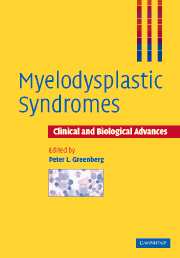Book contents
- Frontmatter
- Contents
- List of contributors
- Preface
- 1 Clinical and prognostic characterization of myelodysplastic syndromes
- 2 Morphologic classifications of myelodysplastic syndromes: French–American–British (FAB) and World Health Organization (WHO)
- 3 Pathogenetic mechanisms underlying myelodysplastic syndromes
- 4 Cytogenetic abnormalities in myelodysplastic syndromes
- 5 Molecular mechanisms and gene expression patterns in myelodysplastic syndromes
- 6 Immunologic mechanisms and treatment of myelodysplastic syndromes
- 7 Biologically targeted therapies for myelodysplastic syndromes
- 8 Supportive care in myelodysplastic syndromes: hemopoietic cytokine and iron chelation therapy
- 9 Hematopoietic cell transplantation for myelodysplastic syndromes
- 10 Health-related quality of life for those with myelodysplastic syndrome: conceptualization, measurement, and implications for research and practice
- Index
- Plate section
- References
1 - Clinical and prognostic characterization of myelodysplastic syndromes
Published online by Cambridge University Press: 22 August 2009
- Frontmatter
- Contents
- List of contributors
- Preface
- 1 Clinical and prognostic characterization of myelodysplastic syndromes
- 2 Morphologic classifications of myelodysplastic syndromes: French–American–British (FAB) and World Health Organization (WHO)
- 3 Pathogenetic mechanisms underlying myelodysplastic syndromes
- 4 Cytogenetic abnormalities in myelodysplastic syndromes
- 5 Molecular mechanisms and gene expression patterns in myelodysplastic syndromes
- 6 Immunologic mechanisms and treatment of myelodysplastic syndromes
- 7 Biologically targeted therapies for myelodysplastic syndromes
- 8 Supportive care in myelodysplastic syndromes: hemopoietic cytokine and iron chelation therapy
- 9 Hematopoietic cell transplantation for myelodysplastic syndromes
- 10 Health-related quality of life for those with myelodysplastic syndrome: conceptualization, measurement, and implications for research and practice
- Index
- Plate section
- References
Summary
The myelodysplastic syndromes (MDS) provide a clinical model for evaluating the evolution of a relatively indolent malignancy into one which is frankly aggressive. The morbidity and mortality in this myeloid clonal hemopathy relate to either marrow dysfunction associated with ineffective hematopoiesis and its peripheral blood cytopenias or to disease evolution into a variant of acute myeloid leukemia (AML-MDS). MDS may arise de novo or is therapy-related (secondary, t-MDS) following treatment with chemotherapy or chemoradiotherapy for other illnesses. The disease is generally relatively indolent, with a rate of progression related to a number of defined clinical features.
Morphologic classifications
The morphologic findings in MDS consist of variable degrees of dysplasia and generally increased or normal marrow hemopoietic cellularity associated with peripheral blood cytopenias and cytopathies. There are currently two morphological classification systems used to categorize MDS patients: the initial French–American–British (FAB) and the more recently proposed World Health Organization (WHO) classification.
French–American–British
The FAB group provided a marrow-based morphologic method for systematically characterizing MDS patients. These features include assessment of the proportion of myeloblasts and degree of dysplasia in the hemopoietic cells, within at least two of the three hemopoietic cell lines. The characteristic MDS features include megaloblastoid erythropoiesis, nucleocytoplasmic asynchrony in the early myeloid and erythroid precursors, and dysmorphic megakaryocytes.
The FAB morphologic classification method separates patients into five subgroups: (1) refractory anemia (RA); (2) refractory anemia with ringed sideroblasts (RARS); (3) refractory anemia with excess blasts (RAEB); (4) refractory anemia with excess blasts in transformation (RAEB-T); and (5) chronic myelomonocytic leukemia (CMML).
- Type
- Chapter
- Information
- Myelodysplastic SyndromesClinical and Biological Advances, pp. 1 - 32Publisher: Cambridge University PressPrint publication year: 2005



